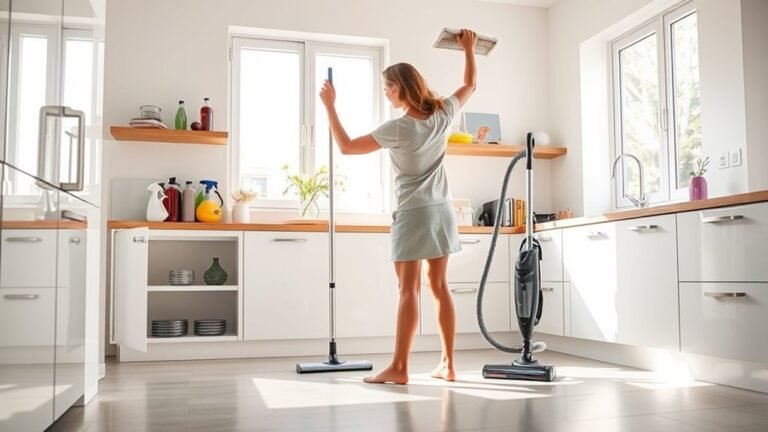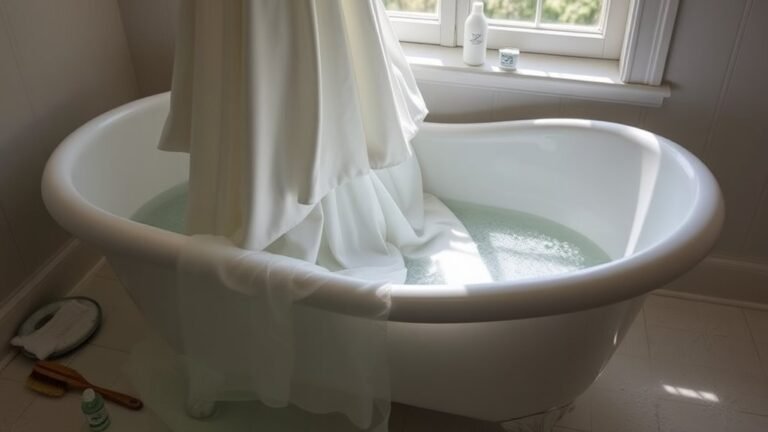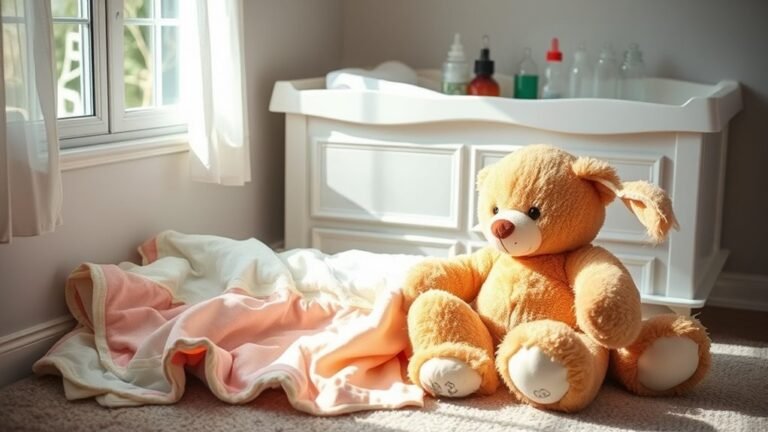How to Clean Your Conference Table Safely
To clean your conference table safely, first identify its material—wood, glass, laminate, or metal—to choose the right approach. Use gentle, non-toxic cleaners and soft microfiber cloths to avoid damage. Always dust off loose debris before applying mild cleaning solutions and test them on a hidden spot. For wood, avoid excess moisture and polish regularly; glass and laminate need streak-free wipes. Mastering these steps guarantees your table stays spotless and protected; more detailed tips can refine your routine further.
Identify the Material of Your Conference Table

Before you begin cleaning, it’s crucial to identify the material of your conference table. Different conference table materials—wood, glass, laminate, or metal—react differently to cleaning agents and techniques. Start by closely examining the surface texture and finish. Wood surfaces might have a grain and a protective varnish, requiring gentle, non-abrasive cleaners. Glass tables are smooth and reflective, needing streak-free solutions. Laminates are durable but can be sensitive to harsh chemicals, while metal surfaces demand rust-preventive care. Identifying table types guarantees you choose the safest cleaning method, preserving the table’s integrity and appearance. Skipping this step risks damage or discoloration. Take a moment to consult manufacturer labels or product guides if available. Knowing your conference table materials is the first move toward effective, confident cleaning without restrictions.
Gather Safe Cleaning Supplies
Since using the right cleaning supplies is essential to protect your conference table, you’ll want to gather products that are both effective and safe for its material. Choosing the correct items guarantees thorough cleaning without damage or residue. Focus on these essentials:
Using the right cleaning supplies ensures effective, safe cleaning that protects your conference table from damage and residue.
- Eco friendly supplies: Opt for biodegradable, non-toxic cleaners to maintain a healthy environment and preserve your table’s finish.
- Disinfecting wipes: Select alcohol-free wipes to sanitize without harsh chemicals that could degrade the surface.
- Soft microfiber cloths: These prevent scratches and trap dust efficiently, guaranteeing a gentle yet thorough clean.
Remove Loose Debris and Dust

Start by removing all loose debris and dust from your conference table to guarantee a clean surface for deeper cleaning. Use a soft microfiber cloth or a gentle brush to perform effective dust removal without scratching the surface. Focus on corners, edges, and crevices where debris tends to accumulate. For larger particles, carefully collect debris using a small handheld vacuum or dustpan to prevent it from spreading. Avoid pushing debris around, as this can scratch or damage the finish. Consistent debris collection guarantees you’re not just moving dirt around but actually clearing it away. By thoroughly removing dust and loose particles, you create an ideal foundation for the next cleaning steps, preserving your table’s appearance and extending its life without relying on harsh chemicals or abrasive tools.
Use Mild Cleaning Solutions
You’ll want to choose mild cleaning solutions with gentle ingredients to protect your conference table’s finish. Avoid harsh chemicals like bleach or ammonia, which can damage the surface and cause discoloration. Using mild solutions not only preserves the table’s appearance but also guarantees a safer environment for everyone in the room.
Choosing Gentle Ingredients
Although it might be tempting to use strong chemicals for quick results, choosing gentle, mild cleaning solutions is vital to protect your conference table’s finish and longevity. Opting for natural alternatives and eco friendly options guarantees effective cleaning without damaging surfaces or harming the environment. Here’s how you can make wise choices:
- Select plant-based cleaners that break down grime without abrasive ingredients.
- Use diluted vinegar or mild soap solutions, which are safe and leave no residue.
- Consider products labeled as biodegradable and free from harsh solvents to maintain both your table’s integrity and indoor air quality.
Avoiding Harsh Chemicals
Since harsh chemicals can quickly degrade your conference table’s finish, it’s important to stick with mild cleaning solutions that effectively remove dirt without causing damage. You should opt for eco friendly options like diluted vinegar or gentle soap mixed with water. These natural alternatives clean thoroughly while preserving the surface’s integrity. Avoid bleach, ammonia, or abrasive cleaners that might strip protective coatings or leave residues. When selecting a product, check for labels emphasizing non-toxic, biodegradable ingredients. Always test your chosen solution on a small, inconspicuous area first to verify it won’t discolor or harm the finish. By prioritizing these mild, natural alternatives, you maintain your table’s appearance and durability, giving you freedom from worrying about costly repairs or environmental harm.
Benefits of Mild Solutions
When you choose mild cleaning solutions, you protect your conference table’s finish from damage that harsh chemicals can cause. Mild detergents and natural alternatives offer a safer way to maintain your table’s appearance without compromising its surface. Here’s why mild solutions work best:
- Preserve Finish Integrity – They clean effectively without stripping varnish or paint.
- Reduce Health Risks – Natural alternatives minimize exposure to toxic fumes, ensuring a healthier workspace.
- Extend Furniture Lifespan – Gentle cleaning prevents premature wear, saving you replacement costs.
Test Cleaners on a Small Area First
Before applying any cleaner to the entire surface, you should always test it on a small, inconspicuous area of your conference table. This precaution helps avoid damage from harsh chemicals or reactions with the finish. Using small patches, apply different test methods to evaluate effectiveness and safety. Observe for discoloration, residue, or texture changes over 10–15 minutes before proceeding.
| Cleaner Type | Test Method | Observation Points |
|---|---|---|
| Mild Soap Solution | Dab & Wipe | No streaks, no dullness |
| Vinegar Solution | Spray & Blot | No discoloration, no damage |
| Commercial Cleaner | Apply with cloth | Residue-free, no sticky feel |
| Alcohol-based | Lightly rub | No finish degradation |
| Water Only | Wipe gently | Baseline for comparison |
Always choose the safest option based on your test results for freedom to clean without risk.
Clean Glass Conference Tables Properly

Cleaning glass conference tables properly requires a careful approach to avoid streaks and scratches that can undermine their sleek appearance. To maintain that freedom of a spotless surface, follow these practical steps:
Proper glass table cleaning preserves their sleek look by preventing streaks and scratches with careful techniques.
- Use glass cleaner alternatives like a mixture of vinegar and water or rubbing alcohol to avoid harsh chemicals that can damage the glass over time.
- Apply the solution with a microfiber cloth, which prevents scratches and helps achieve streak free techniques by absorbing dirt without leaving lint behind.
- Wipe in a consistent circular motion, then finish with vertical or horizontal strokes to eliminate any remaining streaks.
Care for Wooden Conference Tables
Wooden conference tables need regular care to preserve their finish and prevent damage from spills, heat, and scratches. Start with gentle wood care by dusting the surface with a soft, dry cloth to avoid abrasive buildup. For cleaning, use a slightly damp cloth with mild soap—never saturate the wood. Immediately dry to prevent moisture absorption. Avoid placing hot items directly on the table; always use coasters or heat-resistant mats to protect the finish. Regularly apply a quality wood polish or conditioner to maintain luster and shield against wear. Address spills promptly by blotting, not wiping, to prevent stains. These maintenance tips keep your wooden table looking sharp and durable, granting you the freedom to focus on what matters without worrying about damage or costly repairs.
Maintain Laminate Conference Tables
You’ll want to dust your laminate conference table daily using a soft, dry cloth to prevent buildup. Choosing safe cleaning products that won’t damage the surface is essential for maintaining its finish. For stains, apply gentle removal techniques promptly to avoid lasting marks.
Daily Dusting Tips
To keep your laminate conference table looking its best, dusting it daily is essential. Regular daily maintenance prevents dust accumulation, which can scratch the surface over time and diminish its finish. Here’s how you can efficiently manage dusting:
- Use a microfiber cloth: It traps dust without spreading particles, ensuring a clean surface without residue.
- Dust in a consistent direction: Wiping with the grain of the laminate helps avoid streaks and preserves the table’s appearance.
- Avoid using dry dusters: They tend to scatter dust, increasing accumulation rather than reducing it.
Safe Cleaning Products
Choosing the right cleaning products is essential for maintaining the integrity of your laminate conference table. You want to protect its surface while ensuring a hygienic environment. Opt for eco friendly cleaners that are gentle yet effective, preserving the laminate finish without harmful chemicals. Antibacterial options are also vital, especially in shared spaces, to keep germs at bay without damaging the table.
| Product Type | Benefits | Caution |
|---|---|---|
| Eco Friendly Cleaners | Safe for environment & surface | Avoid abrasive scrubs |
| Antibacterial Sprays | Kills germs efficiently | Test on small area first |
| Mild Dish Soap | Removes dirt without damage | Use diluted, not concentrated |
Using these products lets you enjoy a clean, durable table while keeping your workspace fresh and safe.
Stain Removal Techniques
Three effective stain removal techniques can help you maintain the appearance of your laminate conference table without causing damage. Understanding different stain types and choosing the right removal tools is key to preserving your table’s finish.
- Oil-Based Stains: Use a soft cloth with a mild dish soap solution. Gently rub the stain, then wipe with a damp cloth to avoid residue.
- Ink and Marker Stains: Apply a small amount of rubbing alcohol on a cotton ball. Dab gently without saturating the surface.
- Water Rings: Mix baking soda and water into a paste. Apply with a soft cloth, rub lightly, then wipe clean.
Always test removal tools on a hidden area first to guarantee no damage occurs. This approach lets you clean confidently and maintain your table’s freedom from stains.
Dry and Polish the Surface Safely
Although the surface may look dry after cleaning, you’ll want to guarantee it’s completely moisture-free before polishing. Any residual dampness can damage the finish or cause streaks. Use a clean, lint-free microfiber cloth to thoroughly dry the table. When you’re ready to polish, select appropriate polishing techniques based on your table’s material—wood, glass, or laminate each requires different care. Apply polish sparingly to avoid buildup, working in small sections with gentle, circular motions. This not only enhances the table’s shine but also provides surface protection against future spills and scratches. Remember, consistent, careful polishing extends your table’s life and preserves its professional appearance. By following these steps, you maintain both freedom in your workspace and the integrity of your conference table.
Frequently Asked Questions
How Often Should I Deep Clean My Conference Table?
You should set your deep cleaning frequency based on how often the table is used and the surface material considerations. For high-traffic areas, deep clean monthly to keep it pristine. If your table’s wood or delicate, opt for gentle products and less frequent cleanings, maybe quarterly. Adjust according to wear and tear, but regular deep cleaning guarantees longevity and a fresh look, giving you the freedom to focus on your meetings, not maintenance.
Can I Use Homemade Natural Cleaners on My Conference Table?
You can definitely use homemade natural cleaners on your conference table, but keep natural cleaner effectiveness in mind. Some recipes, like a mix of vinegar, water, and a few drops of essential oil, work well for general cleaning without harming surfaces. However, test any homemade cleaner recipes on a small, hidden area first to avoid damage. This way, you stay in control, cleaning safely and effectively with ingredients you trust.
What Should I Do if My Table Gets Stained by Ink?
If your table gets stained by ink, start with ink stain removal by gently blotting the area—don’t rub. Use a cotton ball dipped in rubbing alcohol or a specialized ink remover, applying it carefully to avoid damage. Effective cleaning techniques include testing the solution on a hidden spot first and working from the stain’s edges inward. Wipe away residue with a clean, damp cloth, then dry thoroughly to keep your table looking pristine.
Are There Specific Cleaning Routines for Conference Table Chairs?
You might think cleaning conference table chairs requires a whole cleaning army, but it’s simpler than you imagine. Your chair maintenance routine should depend on the chair material—leather needs gentle wipes with a damp cloth and leather conditioner, while mesh or fabric chairs benefit from vacuuming and spot-cleaning with mild detergent. Regularly check for loose screws or worn-out parts to keep freedom of movement and comfort intact. Staying consistent prevents bigger headaches later!
How Can I Prevent Scratches While Cleaning the Table?
To prevent scratches while cleaning, you need to choose the right cleaning materials carefully. Avoid abrasive sponges or harsh chemicals that can damage the surface. Instead, use a soft microfiber cloth and gentle, non-abrasive cleaners designed for your table’s finish. Always wipe in the direction of the grain to minimize friction. Taking these steps guarantees effective scratch prevention, letting you maintain your table’s look without restricting your cleaning freedom.






